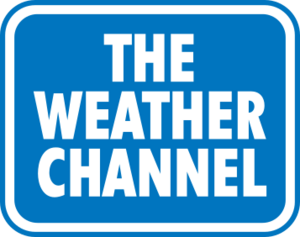History of The Weather Channel facts for kids
The Weather Channel is a TV channel in the United States. It shows weather information from all over the country and the world. Lately, it also has fun shows about weather. This article tells you about the channel's history, which started around 1980.
Contents
- How The Weather Channel Started
- The Early Years (1982–1986)
- New Look and Slogans (1986–1996)
- Big Changes and "Local on the 8s" (1996–2001)
- The "Live By It" Era (2001–2005)
- "Bringing Weather to Life" (2005–2008)
- Sale to NBC and HD Transition (2008–2013)
- "It's Amazing Out There" (2013–Present)
- Sale to Entertainment Studios
- See also
How The Weather Channel Started
Before The Weather Channel, people thought about showing weather on TV way back in the 1950s and 1960s. This was on early cable TV systems. These systems often had extra channels.
Some cable companies used a simple black and white camera. It would move around to show different weather tools. These tools showed the time, temperature, wind speed, and more. They also showed forecasts and local news.
The idea for The Weather Channel came from a TV meteorologist named John Coleman. He shared his idea with Frank Batten, who led a company called Landmark Communications. A big part of the plan was to give viewers local weather.
They would do this using special computers called WeatherStars. These "STAR" units would be put in local cable TV offices. They could add local weather conditions and warnings to the national TV feed. The Weather Channel company officially started in Atlanta, Georgia, on July 18, 1980.
The Early Years (1982–1986)
The Weather Channel began broadcasting on Sunday, May 2, 1982. The first official show was at 8:00 p.m. Eastern Time. It was hosted by meteorologists Bruce Edwards and André Bernier.
The channel first focused only on weather reports. It got its national forecasts from the National Oceanic and Atmospheric Administration (NOAA). Local forecasts came from the National Weather Service. In 1983, John Coleman left his role as the channel's president.
The first Weather Star computer had some issues. These were fixed with the Weather Star II in 1984. Later, the channel released the Weather Star III in 1986. This new unit had better features and more forecast options.
New Look and Slogans (1986–1996)
On June 29, 1986, The Weather Channel changed its format. It became "The New Weather Channel" and started using anchors. A new slogan was "You Need Us, The Weather Channel, For Everything You Do."
In 1989, they added "Prime Time Tonight." This short segment showed what was on other cable channels.
The first Weather Star 4000 models came out in 1990. At first, they only showed text. But later that year, they added radar images and colorful backgrounds. This made the 4000 the first STAR unit to show graphics.
In March 1991, The Weather Channel got a big new look. Its new slogan was "Weather You Can Always Turn To." The channel also launched a phone service for weather information. By 1993, most U.S. homes with cable could watch The Weather Channel.
In 1994, TWC ordered 1,000 units of a simpler STAR model called the Weather Star Jr. In 1995, the channel started showing "Local Update" forecasts. These were from the National Weather Service. New shows like WeatherScope also started.
Big Changes and "Local on the 8s" (1996–2001)
The Weather Channel changed its look a lot in 1996. A new slogan was "No Place on Earth Has Better Weather." On April 15, 1996, they got a new, simpler logo and new graphics. The Weather Channel also launched its website that year.
A popular new feature called "Local on the 8s" started. This meant local forecasts would air for ten minutes. They would start at eight minutes past the hour. This idea was brought back later and is still used today.
In October 1996, The Weather Channel moved to a new building in Atlanta. By 1996, 63 million homes could watch the channel.
On March 11, 1998, TWC updated its graphics again. They used cloud footage and a new font. WeatherScope was replaced by Weather Center. This show covered weather all day, with different parts for morning, afternoon, and evening.
The Weather Star XL was released in 1998. This new STAR unit had much better graphics. It could show animated forecasts and new weather icons.
In 1999, The Weather Channel launched a spin-off channel called Weatherscan Local (now Weatherscan). This channel showed continuous local weather. By 1999, TWC reached 70 million homes.
In 2000, the Weather Star XL systems added a voice feature called Vocal Local. This voice would read out forecasts. The channel also started new morning shows like First Outlook and Your Weather Today.
The "Live By It" Era (2001–2005)
On June 25, 2001, The Weather Channel introduced new looks for its local forecasts. It also got a new slogan: "Live By It." The different Weather Center shows were combined into one general program. New shows like Evening Edition and Weekend Now also started.
In September 2001, the Weather Star XL got a new look. It had different colors, a new cloud background, and better maps.
In April 2002, The Weather Channel started making its own local forecasts. Before, these came from the National Weather Service. TWC celebrated its 20th anniversary in May 2002. They showed a special program and released a book about the channel's history.
In 2003, the channel started showing longer programs. Storm Stories was the first show that wasn't just weather forecasts. Weatherscan also got a new look and moved to a newer computer system called the IntelliStar. This system was more flexible for updates.
In 2004, the IntelliStar systems started being used across the U.S. They generated local forecasts for The Weather Channel. The older Weather Star III was stopped because it didn't meet new rules.
"Bringing Weather to Life" (2005–2008)
In 2005, The Weather Channel announced a big new look. This new look started on August 15, 2005. It included a simpler square logo and a new slogan: "Bringing Weather to Life." More long-form shows like The Climate Code also began.
In May 2007, The Weather Channel celebrated its 25th anniversary. They used a special 25th-anniversary logo. On September 26, the channel launched a high-definition version.
Sale to NBC and HD Transition (2008–2013)
On June 2, 2008, The Weather Channel updated its look again. This included new graphics and new opening videos for its shows. They also moved into a new high-definition studio.
On July 7, 2008, NBC Universal and some other companies bought The Weather Channel. They paid $3.5 billion for it. Because of this, TWC started working with NBC. Live shows on TWC began using videos from local NBC stations during big weather events. TWC meteorologists also appeared on NBC News.
In November 2008, The Weather Channel joined NBC Universal's "Green is Universal" campaign. This promoted environmental awareness.
In February 2009, The Weather Channel made some big changes to its schedule. Several shows were removed or changed. Storm Stories returned for "Tornado Week." TWC personalities also started using Twitter more.
On March 5, 2009, Geoffrey Darby became the new Executive Vice President of Programming. Under him, the jazz music played during local forecasts was replaced with instrumental rock music. TWC also started showing weekly movies on Friday nights. This decision was not popular with many viewers. After some issues, TWC stopped showing movies in May 2010.
In 2011, the Intellistar 2 was slowly rolled out. This was the first STAR unit that could show high-definition graphics. It was used for "Local on the 8s" on the HD channel.
The Weather Channel celebrated its 30th anniversary in May 2012.
"It's Amazing Out There" (2013–Present)
On November 12, 2013, The Weather Channel launched a new look. It was like a mobile app. The channel also started showing its lower display line during commercials. Many of its forecast shows were combined under the Weather Center Live name. A new studio set also debuted. The Weather Channel also introduced new slogans like "It's Amazing Out There."
On December 2, 2013, Good Morning America weather anchor Sam Champion joined The Weather Channel. He became the channel's weather editor and a meteorologist. On March 17, 2014, Champion started hosting a new morning show called America's Morning Headquarters.
On January 14, 2014, DirecTV stopped carrying The Weather Channel. This was because they couldn't agree on a new contract. DirecTV replaced TWC with WeatherNation TV. DirecTV said subscribers complained about too many reality shows on The Weather Channel. On April 8, 2014, TWC and DirecTV reached a new deal. TWC returned to DirecTV, and the channel agreed to show fewer reality programs during the day.
On March 10, 2015, Verizon FiOS also stopped carrying The Weather Channel. They replaced it with the AccuWeather Network. Verizon said people could get weather info from the internet and mobile apps. The Weather Channel returned to Verizon Fios on June 24, 2019.
On August 20, 2019, The Weather Channel updated its graphics again. They removed the "L" bar and made the display wider for modern TVs.
Changes to Shows
In late 2015, The Weather Channel started making big changes to its shows. On August 24, they launched Weather Underground. This show looked deeply into how weather works.
On September 2, 2015, The Weather Channel announced it would cancel Wake Up with Al. The channel also said it would stop making new long-form shows. Instead, it would focus more on live weather forecasts. The CEO of The Weather Company said that fans come to them for weather and science, not for other shows.
As part of these changes, The Weather Company laid off about 50 employees. The channel also announced a new service called Local Now. This service would provide local weather, traffic, and news for streaming services.
Sale to Entertainment Studios
On March 22, 2018, a company called Entertainment Studios, owned by Byron Allen, bought The Weather Channel's TV parts. The value was about $300 million. The Weather Channel's other parts, like its website, were sold to IBM two years before.
See also
- NBCUniversal
- Landmark Media Enterprises
- Entertainment Studios





